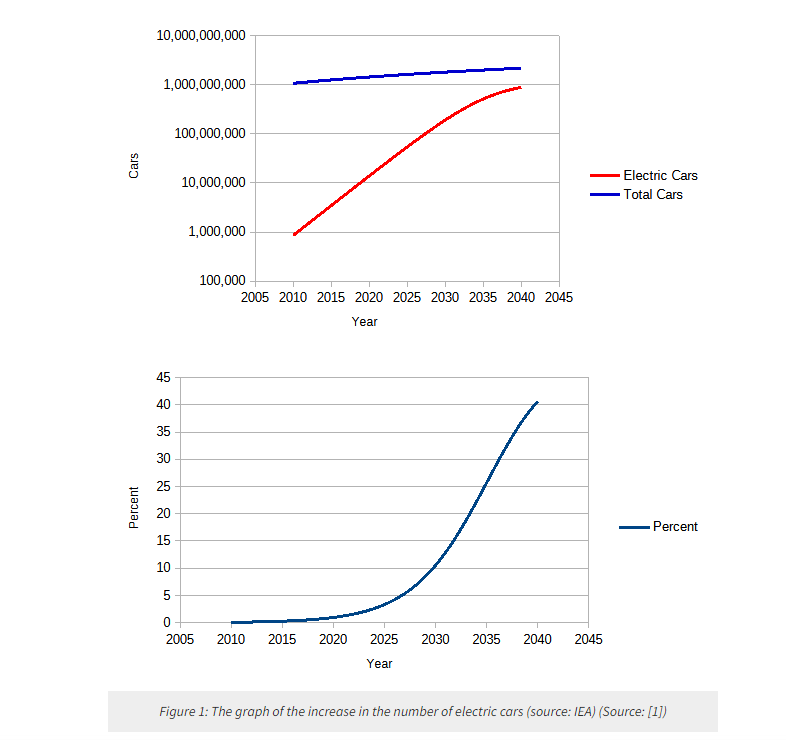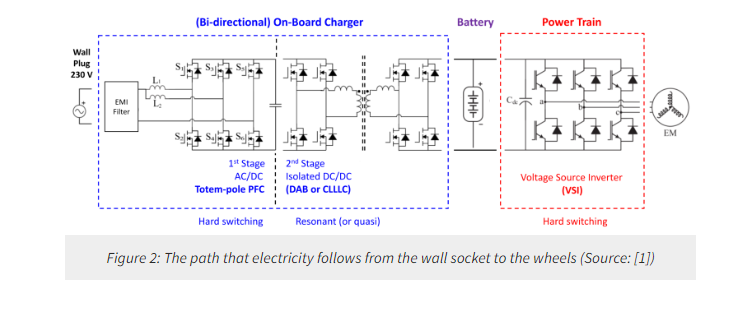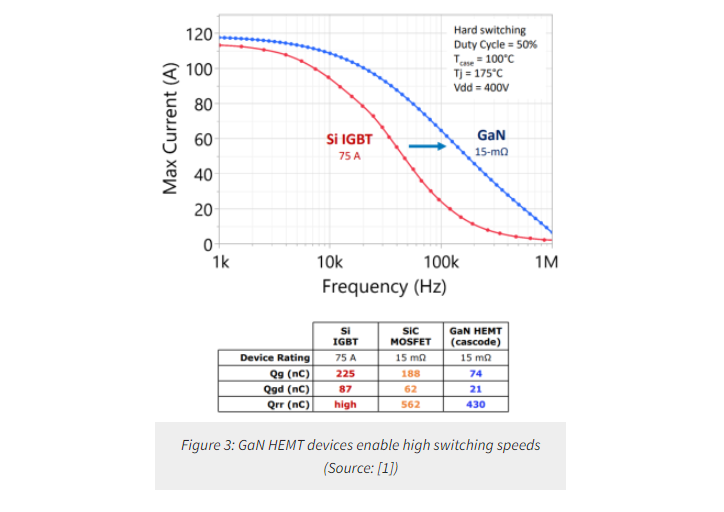
The automotive industry’s evolution is leading to a growing demand for electric vehicles (EVs) that provide a more sustainable and environmentally friendly driving experience. However, to make EVs an affordable and accessible reality, the efficiency of the electronic components used for power conversion must be improved. In this context, 650V and 1200V high-power GaN devices are emerging as promising solutions.
GaN devices
GaN (Gallium Nitride) devices are high-speed, high-power devices offering superior performance than conventional silicon transistors. Due to their great flexibility, they can operate at very high switching frequencies and with superior energy efficiency. This makes them ideal for EV applications, where efficiency and compatibility are critical to ensure maximum energy efficiency and range. High-power 650V and 1200V GaN devices can handle high currents and voltages, making them suitable for automotive power supply. Moreover, they offer greater reliability than silicon transistors due to their resistance to high temperatures and electrical stress. Another advantage of GaN devices is their compactness, making them suitable for automotive applications with limited space, such as onboard chargers. Due to their high efficiency, GaN devices can also reduce the size and cost of cooling systems, improving the convenience and reliability of the overall system.
One of the most significant challenges: saving volume
Power electronic circuit designers are constantly trying to reduce the size of their products, thereby increasing the density of electronic components within a single device. This allows for more space and volume while reducing bulk and weight. GaN has unique characteristics making it particularly suitable for high-frequency and energy-efficient power applications. Due to its high heat dissipation capacity and its resistance to the negative effects of the electric field, GaN allows for smaller and more compact devices. Thus, higher performance and greater efficiency can be achieved in various applications, from energy conversion to power electronics. Devices for which smaller footprints are needed cover a wide range of applications, including:
● Power supplies for wall plugs (20 W – 100 W)
● Adapters (50 W – 300 W)
● Power supplies (1 kW – 4 kW)
● Inverters for photovoltaic applications (0.5 kW - 5 kW)
● Servomotors (0.5 kW - 5 kW)
● Onboard battery chargers (3.3kW - 25kW)
● Traction powertrains (20 kW – 350 kW).
In reality, the applications are much greater in number, and it is expected that their size and weight characteristics may also improve in a short time.
World governments’ policies and manufacturers’ commitments
In recent years, concern about the environmental impact of fossil-fueled vehicles has urged many governments and automobile manufacturers to commit to zero-emission vehicles. They are powered by renewable energy sources or environmentally friendly technologies, such as hydrogen fuel cells or lithium-ion batteries. Globally, many governments have introduced policies encouraging zero-emission vehicle purchase and use. Many have set some goals to reduce greenhouse gas emissions and incentivize using electric vehicles.
They have also set goals for the sale of zero-emission vehicles so that within a few decades all cars must be of this type. Low-emission zones have been introduced in many countries where high-emission vehicles are banned or subject to many restrictions. Many car manufacturers strive to create zero-emission vehicles by introducing electric or plug-in hybrid car models, which combine electric and internal combustion engines. Other manufacturers are also investing in hydrogen fuel cell technology. Either way, soon all manufacturers will announce their own full zero-emission productions. As shown in the graph in Figure 1, the total number of cars worldwide has approximately doubled linearly over the 15-year interval and will continue to do so for another 20 to 25 years, with the same incline.
Quite different, however, is the fate of electric cars alone. In fact, we can see an exponential year-by-year increase that will result in a majority presence of electric cars. The graph below, however, shows the percentage of the number of electric cars to the total number of cars on the road. It can be seen that until 2025 the number of electric cars is in the clear minority. Still, they are predicted to begin soon to spread exponentially, and already, by 2030 their number will be 10 percent of the total number of vehicles. By 2035 the number of electric cars will rise to 25 percent, and by 2040 they will make up 40 percent of the entire fleet. Therefore, 2030 is the beginning of the world’s real spread of electric cars.

Onboard electronics
Power electronics requirements in an automotive system are essentially those of efficiency, power, and reliability. In fact, designers precisely prioritize these aspects. An electric vehicle generally consists of the following power electronics elements:
● A few 400 V or 800 V batteries
● An AC-DC and DC-DC onboard charger (OBC) ranging in power from 3 kW to 25 kW
● An offboard charger
● A DC-DC auxiliary power module with power ranging from 1 kW to 10 kW
● An inverter
● A DC/AC powertrain ranging from 30 kW to 250 kW.
These are components and devices through which so much current circulates and work at very high electrical potentials. Without today’s power devices, electric vehicles would be almost impossible. In an electric car, electricity travels from the electrical outlets on the wall to the wheels (see the relevant diagram in Figure 2). Operating factors in such electric circuits, including high frequency and high efficiency, must coexist. The various elements that make up the electrical conveyance system are as follows:
● The wall outlet in one’s home generally provides a voltage of 240VAC. This is a Wall Plug, which allows a power cord to be connected to the car to allow batteries to be recharged
● An EMI filter, which is intended to reduce electromagnetic noise that can interfere with the proper functioning of the system and improves the quality of the electrical signal transmitted to the vehicle
● A bidirectional onboard battery charger, consisting of an AC-DC hard switching first stage and a resonant isolated DC/DC second stage
● The vehicle’s battery
● The powertrain, consisting of a voltage source inverter (VSI) operating in hard switching.
The system would develop much heat for the high powers involved, but this issue can be solved thanks to the technologies achieved by the new electronic switching components (GaN). Indeed, at the same nominal voltage, the performance of GaN devices is far superior to silicon devices.

GaN HEMTs
Gallium Nitride (GaN) High Electron Mobility Transistors (HEMTs) are part of the next generation of RF power transistor technology. They are new high-frequency devices that exploit the unique properties of Gallium Nitride to implement high-speed, high-power devices. They are characterized by higher mobility and, most importantly, a much lower specific Rds(on) value. This allows transporting a high current rate with minimal power dissipation and lower conduction losses. In addition, they can handle high voltages (above 650V) and allow switching at very high speeds.
One of the main advantages of GaN HEMTs over other semiconductor devices is their ability to operate at very high voltages and currents, allowing high power with low power loss. This makes them ideal for high-frequency and high-power applications. GaN HEMTs also exhibit greater reliability than other high-frequency devices due to their greater resistance to high temperatures and greater tolerance to power surges. In addition, Gallium Nitride has greater resistance to atmospheric conditions than other semiconductor materials, making it suitable for outdoor applications.
One of the main prerogatives of these devices is the high operational speed of switching (see the graph in Figure 3). The two devices in the graph, showing the maximum current as a function of frequency, are a GaN and an IGBT. Evidently, there is a decrease in maximum current, with a nonlinear trend, as frequency increases.
Moreover, it exhibits that GaN can handle a higher current than IGBT at all frequencies considered. These data suggest that GaN is a more suitable device for handling high frequencies and currents, allowing greater energy efficiency, as it has a very low internal resistance that reduces power losses during operation.

Example of a boost circuit
Figure 4 shows an example of a DC-DC CCM Boost converter, with input and output voltage equal to 240V – 400V. It has the following characteristics:
● Gate Driver = Si8285 (4 A)
● Gate Voltage = 0 V -12 V
● Rg,on = 5 ohms
● Rg,off = 15 ohms
● Deadtime = 300 ns
● Ferrite Bead = 120 ohms at 100 MHz
● DC Snubber = 10 nF + 2 ohms.
This is a 10kW solution whose conversion is driven through a 100 kHz switching signal. The corresponding graph also shows the efficiency curves at the switching and driving frequencies of 50 kHz, 70 kHz, and 100 kHz.

Conclusion
High-power 650V and 1200V GaN devices are rising as promising solutions for EV applications and can deliver superior energy efficiency, increased reliability, space optimization, and reduced overall system costs. These devices represent a key technology for making EVs an affordable and accessible reality for an increasingly broad audience. Several newly developed converter topologies using FQS devices are currently being investigated in academic research centers. Such solutions are more complex when IGBT and SiC components are used. Still, they are certainly simpler with the use of GaNs, which allow for superior switching performance, a wide voltage range (up to 1.2kV), a wide power range (even above 10kW), high reliability, excellent short-circuit responses, and excellent four-quadrant switching capability.
About US
Heisener Electronic is a famous international One Stop Purchasing Service Provider of Electronic Components. Based on the concept of Customer-orientation and Innovation, a good process control system, professional management team, advanced inventory management technology, we can provide one-stop electronic component supporting services that Heisener is the preferred partner for all the enterprises and research institutions.
